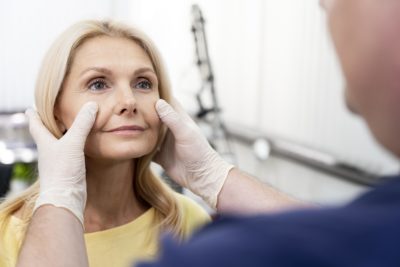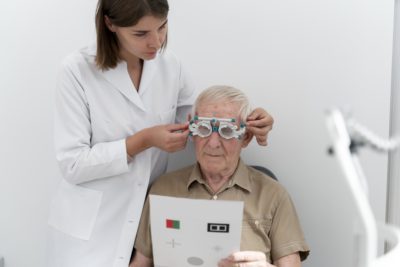A pterygium is an elevated, flesh-like growth with a triangular shape that develops on the conjunctiva of the eye. It is primarily caused by prolonged exposure to UV light. In mild cases, it can lead to symptoms like redness, swelling, and eye irritation. As it grows, it may obstruct or blur your vision. Treatment options range from relieving symptoms with eye drops and ointments to surgical removal when it affects vision.
What is Pterygium?
Pterygium is a pink, vascular tissue that can extend from the conjunctiva onto the cornea. If it encroaches into the visual path, it can disrupt vision. These growths usually originate from the inner (nasal) side of the eye, growing towards the pupil, but can also occur on the outer (temporal) side.
Pterygium is more prevalent in regions near the equator with prolonged sun exposure, particularly to ultraviolet (UV) rays. Some believe chronic eye irritation may also contribute. Therefore, it’s more common in people who spend time outdoors, especially in sunny climates. Pterygiums are benign growths, meaning they are not cancerous. They don’t invade the eye, sinuses, or brain, and they do not spread to other parts of the body. They can affect one or both eyes but rarely occur in both eyes simultaneously, a condition known as bilateral pterygium.
Why is it Called a Surfer’s Eye?
The term “surfer’s eye” is coined because surfers often work in the same environmental conditions that promote pterygium growth, including sun, wind, and dusty surroundings.
Diagnosing pterygium is usually straightforward. An eye doctor can typically identify it during a physical examination using a slit lamp, which provides magnified and well-lit views of the eye. Additional tests, if needed, may include a visual acuity test (reading an eye chart), corneal topography (measuring corneal curvature changes), and photo documentation (taking pictures to track pterygium growth over time).
What are the Complications?
A nasal pterygium is a growth of tissue on the eye’s conjunctiva (the clear tissue that covers the white part of the eye) that can extend onto the cornea (the clear front surface of the eye). While nasal pterygiums are typically benign and non-cancerous, they can lead to various complications and discomfort. Some of the potential complications and issues associated with nasal pterygium include:
-
Vision Disturbance:
If the pterygium grows over the cornea, it can cause irregular astigmatism, which may result in blurred or distorted vision. In severe cases, it can even lead to visual impairment.
-
Dry Eye Syndrome:
Pterygium can disrupt the normal tear film on the eye’s surface, leading to dry eye symptoms, such as itching, burning, redness, and discomfort.
-
Irritation and Discomfort:
Pterygium can cause a feeling of irritation, foreign body sensation, and redness in the affected eye. This can be bothersome and lead to constant discomfort.
-
Corneal Ulceration:
In rare cases, if the pterygium becomes inflamed and thickens significantly, it may cause corneal ulcers, which are open sores on the cornea. Corneal ulcers can be painful and may lead to severe vision problems if not treated promptly.
-
Cosmetic Concerns:
Pterygiums can be unsightly and may cause cosmetic concerns, particularly if they become large or grow in a way that affects the appearance of the eye.
-
Recurrence:
After surgical removal of a pterygium, there is a risk of recurrence. The rate of recurrence can vary, and it may require additional treatment or surgery.
-
Diplopia (Double Vision):
In some cases, the growth of the pterygium may interfere with the normal alignment of the eyes, leading to double vision (diplopia).
-
Visual Distortion:
When the pterygium extends onto the cornea, it can induce irregular astigmatism and distort the way light enters the eye, affecting vision quality.
Treatment Options for Nasal Pterygium
The treatment options for a nasal pterygium (a growth of tissue on the eye’s conjunctiva that can extend onto the cornea) depend on the severity of the condition, the presence of symptoms, and the impact on vision. Here are some common treatment options:
-
Observation:
If the pterygium is small, not causing symptoms, and not affecting vision, your eye doctor may recommend regular monitoring without immediate intervention.
-
Artificial Tears:
Lubricating eye drops (artificial tears) can help relieve dryness, redness, and irritation associated with a pterygium. These drops may be used as a first-line treatment to manage mild symptoms.
-
Steroid Eye Drops:
Non-preserved steroid eye drops can be prescribed to reduce inflammation and discomfort caused by the pterygium. These drops are typically used for short-term relief and under the supervision of an eye care professional.
Surgical Removal:
If the pterygium is causing significant discomfort, vision problems, or cosmetic concerns, surgical removal may be recommended. There are different surgical techniques for pterygium removal, including:
-
Excision with Conjunctival Autograft:
This is one of the most common surgical approaches. The pterygium is surgically removed, and a piece of healthy conjunctival tissue is harvested from another part of the eye (usually the same eye) and transplanted onto the area where the pterygium was removed. This helps reduce the risk of recurrence.
-
Amniotic Membrane Graft:
In some cases, an amniotic membrane graft may be used instead of conjunctival tissue. The amniotic membrane is obtained from the inner lining of the placenta and has anti-inflammatory properties, which can aid in the healing process.
-
Adjuvant Therapies:
Some surgeons may use adjuvant therapies during surgery or postoperatively to minimise the risk of recurrence, such as mitomycin C or beta radiation therapy.
-
Refractive Correction:
After surgical removal of a pterygium, refractive errors like astigmatism may need to be addressed with glasses or contact lenses to optimise vision.
-
Postoperative Care:
Following pterygium surgery, it’s crucial to follow your surgeon’s postoperative care instructions carefully. This may include using eye drops, avoiding eye rubbing, and protecting the eye from excessive sun exposure.
-
Recurrence Management:
Even after successful surgical removal, there is a risk of pterygium recurrence. If recurrence occurs, additional treatment or surgery may be necessary.
Hence, managing nasal pterygium can pose challenges, but with the right diagnosis and treatment plan, it can be effectively addressed. If you suspect that you have nasal pterygium, consider consulting with a qualified eye specialist. They can help you identify the extent of the growth and recommend the best course of treatment to address the issue.
Further, Dr. Agarwal’s Eye Hospitals can provide you with useful prevention tips and guide you on how to maintain proper eye health to prevent the recurrence of nasal pterygium. Overall, with proper diagnosis, treatment, and preventive measures, you can effectively manage nasal pterygium and maintain healthy eyes.









